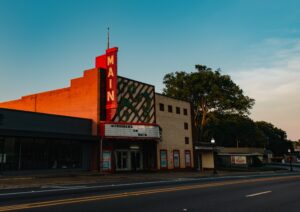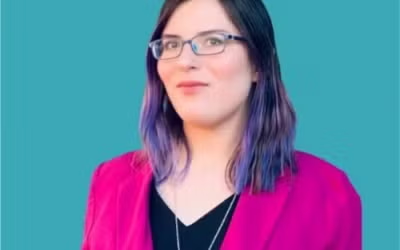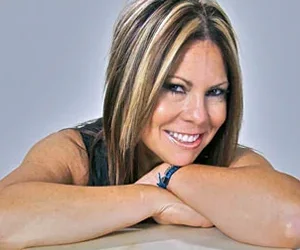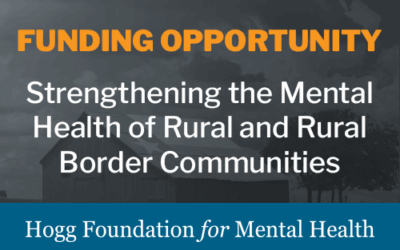When it comes to supporting rural communities, especially around mental health, success often starts not with answers, but with questions—and a deep commitment to listening.
In our latest episode of Into the Fold, host Ike Evans speaks with Tammy Heinz, senior program officer and consumer and family liaison at the Hogg Foundation, Rick Ybarra, senior program officer at the Hogg Foundation, Brian Dabson, rural policy analyst and researcher, and Allen Smart, advisor to philanthropy and nonprofits and Hogg Foundation National Advisory Council member. Together, they reflect on years of work in rural communities across Texas and beyond, revealing key lessons for philanthropic funders who want to make a meaningful, sustainable difference.
Start by Stepping Back
Too often, funders enter communities with pre-packaged solutions. But according to Tammy, the real innovations happen when community voices are centered from the start. “We don’t need to come in with all the answers,” she says. “We need to give people the flexibility to identify or create the answers, to identify the answers, and then step back.”
This approach, Tammy says, has led to surprising and effective grassroots strategies that reflect the real needs and strengths of rural communities—strategies that may never have emerged from a traditional “top-down” model of funding.
Rick adds that setting an aspirational goal—like creating mentally healthy communities—without dictating how to get there can be a powerful motivator. “We say, here’s our aspirational goal. You inform us on how that’s going to happen,” he says. “That really sets our projects apart.”
Trust Is Not a Buzzword
While “trust-based philanthropy” has become a popular term in recent years, trust must go deeper than jargon. There will always be a power dynamic, no matter how well-intentioned a funder may be, says Brian. Communities, especially those with limited funding history, will naturally try to “figure out what the funder really wants,” often prioritizing that over their own instincts, he adds.
That’s why setting mutual expectations early—and revisiting them often—is critical. Trust must be visible. “People have to see that it’s real,” says Allen. “They have to see you are providing value. You’re not just running them through a series of meetings.”
Small wins, like securing an extra day of service at a local mental health clinic or creating a community gathering space, can build the momentum and confidence needed for long-term change.
Fund the Process, Not Just the Product
Tammy emphasizes the importance of supporting a community’s journey, even when the results don’t fit neatly into a traditional grant report. “We don’t set the measurement,” she says. “Instead, we have technical assistance available for our communities to work with, to determine what they want to measure.”
This focus on the process over the product can be difficult for traditional funders to accept. But it acknowledges a critical truth: change takes time, and communities often already know what needs to be done. What they need is support, flexibility, and affirmation.
Reimagining the Role of the Funder
 Doing this kind of community-engaged work means more than tweaking how grants are administered. It requires a complete rethinking of what it means to be a funder. Rick describes the modern program officer as more of a “cheerleader, coach, and sometimes marriage counselor.”
Doing this kind of community-engaged work means more than tweaking how grants are administered. It requires a complete rethinking of what it means to be a funder. Rick describes the modern program officer as more of a “cheerleader, coach, and sometimes marriage counselor.”
For the Hogg Foundation team, that has meant learning when to advise and when to step back. “We would turn around and say to them, ‘We want you to find the answers in your own community,’” says Tammy. “We don’t have the solutions sitting in our offices in Austin.”
That delicate balance—of providing support without overtaking the process—is a core element of emotionally intelligent philanthropy.
Rural Communities Are Not Monolithic
Both Brian and Allen emphasize the need to resist one-size-fits-all approaches. “There isn’t a single ‘rural America’,” Brian says. “Every community has its own legacy, its own challenges, its own opportunities.”
Funders must also resist “educating” rural communities about their own problems. The community is already aware of the things they want to see change. “They are very, very aware of the problems in their communities and want to be in a much better situation,” says Allen.
Instead, funders should amplify local strengths and ideas. From reimagining old church buildings as mental health hubs to building grassroots mental health worker programs, rural communities already have the creativity and commitment needed to solve their challenges—they just need the trust and support from funders to do it.
Looking Ahead
There’s no simple answer. But as the experience of our guests shows, the best way forward is through humility, collaboration, and an unwavering belief in the power of community-led change. “If a car is stalled out on the road and only one person pushes, it’s not going to go far,” says Rick. “But if people are inspired by a common vision and all push in the same direction, you can get that car to move.”
That’s grassroots innovation. And it works.
Let Community Drive the Work: A Conversation with Larissa Minner
In this episode of the podcast, Larissa Minner, a researcher at the Texas Center for Disability Studies at the University of Texas School of Social Work and director of the Weaving Inclusion Together in research Hub (WITH), joins us for an exploration of how small-scale changes to everyday practice can catalyze deeper change not only to lives, but to systems.
Rebuilding Trust in Our Systems of Care
Trust is the foundation of every system that is supposed to support us—schools, hospitals, mental health services, and even the justice system. But for many communities, that trust has been broken again and again.
Root-Bound or Growth Mindset?
A growth mindset is the belief that skills and abilities can be improved and that developing these is the purpose of your actions.
Rhythms of Resilience: An Early Look at the Robert Lee Sutherland Seminar
This year’s RLS seminar will feature a keynote experience unlike any other—a powerful blend of rhythm, connection, and healing led by Grammy Award–winning percussionist Nina Rodriguez.
Strengthening the Mental Health of Rural and Rural Border Communities
Building on community strengths and fostering community-driven solutions.
Children of Change: Supporting Youth Mental Health in an Uncertain World
We take a deep dive into youth mental health, the pressures on families and educators, and the community-driven solutions that offer hope.






